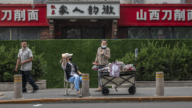【新唐人2014年07月25日讯】国际“渣打银行”的研究专家日前估算,目前中国债务占GDP的比重已经达到251%,突显中国经济面临的巨大挑战。中国整体经济增长率不断放缓,而债务不断增加,专家认为,当前已经不可能再靠印制钞票来解决金融危机,一旦危机出现,比较中国和其他西方经济体所受的冲击,在中国,吃亏的是民众,而西方却是政府在承担。
“渣打银行”(Standard Chartered)大中华区研究部主管王志浩(Stephen Green)在7月21号发表文章说,到6月底,中国总债务与国内生产总值(GDP)之比,达到251%,远高于2008年底的147%,以及去年中共官方公布的215%。
旅美经济评论家马杰森:“都是猜测的数字,实际是多少,这是中共的国家机密,还有很多隐藏的债务。举个例子,地方政府它不直接借贷,它建立一个公司,用这个公司借债,而这个公司的形式是千奇百怪,有地方政府独立管理的,有合资的。”
中国金融智库研究员巩胜利透露,中共的人材工程、公关、统战、文联、作协以及中共从上到下的党委开支,都会保密。
中国金融智库研究员巩胜利:“中国资产的黑洞到底有多大,只能预料,不能判断,有些背后的那些就没有计算进去,它公布的数据,通常是不包括党的数据的,这个数据就很大很大。”
中国的经济增长率不断放缓,而债务却不断增加。从空荡荡的公寓楼群,到太阳能电池板、钢铁和水泥等众多行业大规模产能过剩等,可以看出资本严重配置不当。
尽管如此,英国《金融时报》22号的文章说,中共政府因为担心不断放缓的经济增长,和房地产市场的下挫,可能导致经济“硬着陆”,不但没有遏制信贷,反而允许信贷加快。报导说,6月份,中国新增信贷总计达到1万9600亿元人民币,创下3月以来最高的月度数据,同比接近高出一倍。
中国全社会债务存在的风险,首先是,过度集中到了房地产领域。房地产贷款期限长,流动性极差,一旦泡沫破灭,不能及时变现,将快速放大金融风险。
第二个风险是“地方融资平台债务”。“中国社科院”副院长李扬曾在去年发文指出,地方融资平台的债务,大多数是在长达十年的过度追求GDP政绩的情况下,盲目扩张的,主要集中投向城市基础设施的建设,特别是大造新城,甚至“鬼城”,大造大广场、超大型机场等上面。而地方债务投向特点是期限长、流动性差,而且回报非常之低,收入回报根本覆盖不了债务本息。被外界称为“永不到期的贷款和债务”。
除了中国以外,世界上少数几个债务比率较高的经济体,都是高收入经济体。去年,美国的总债务与GDP之比大约是260%,而英国为277%,按照“渣打”的计算,日本以415%的比率在这方面领衔世界。
那么,中国的负债和这些国家有什么不同呢?
杰森:“整个西方社会它们的债务根本原因是庞大的社会福利承诺,只要这些社会福利在万不得已的情况下,稍微削减一点整个债务就会大幅度地减少,而中国这一点上大量是被贪官拿走了,一旦未来财政吃紧的时候,他会用它的权力去从百姓那里掠夺更多,那个时候就是直接的社会的冲突,而美国这边往往削减赤字的过程中,政府官员首先承担第一手打击。”
前年,中国城市房地产占到GDP的385%。而在美国即使在2005年,房地产泡沫达到顶峰时,房地产总价值也只占GDP比重的172%,最终却引爆了2008年金融危机。
大陆经济评论家牛刀指出,为了避免危机,中共又印制钞票,来凝固钢筋水泥。而货币严重超发后,再度直接引发通货膨胀和房屋等资产价格上涨,使得经济总量,过度依赖债务膨胀来垒高。
不过、尽管今年中共已经印制出接近GDP两倍的钞票,房价还是一直持续下滑。马杰森认为,中国目前面临的问题,已经无法靠印制钞票来解决,种种迹象表明,中国经济和政治上的问题都在向一个爆发点推进。
采访编辑/刘惠 后制/李智远
China’s Debt is 251 Times GDP – Western Comparisons
Standard Chartered Bank International experts recently
estimated that China's current debt-GDP ratio is 251%,
showing the enormous challenges faced by the Chinese economy.
China’s overall economic growth keeps slowing down,
while debt keeps increasing.
Experts believe it is impossible to rely on printing money
to solve the financial crisis.
Once the crisis comes to the surfaces, Chinese people will
suffer more compared with the crisis in Western economies
where the government takes the burden.
Standard Chartered Bank head of research for Greater China,
Stephen Green published an article on July 21, stating that:
China’s total debt to GDP ratio reached 251% at end of June,
far higher than 147% at the end of 2008, and 215%
published by Chinese Communist Party (CCP) in 2013.
US-based economic commentator Ma Jiesen:
“The figures are just estimates. The actual number is a CCP’s
state secret.
There are a lot of hidden debts. For example, a local
government can set up a company and get loans in the name
of this company.
These companies are run in different forms,
some are directly managed by the local government
and some are joint ventures."
China financial think tank researcher Gong Shengli revealed,
that expenses from top to bottom of the CCP,
human resources engineering, public relations, united front,
writers and CCP party committee are all kept confidential.
Gong Shengli: “How big is the black hole of China's assets
can only be estimated, not judged.
Some data behind the scenes are not included. The data CCP
publishes usually do not include the party's expenses, which
by itself are huge."
China’s economic growth keeps slowing down,
but the debt has continued to increase.
Empty apartment buildings and overproduction of solar panels,
steel and cement indicate serious misallocation of capital.
Nevertheless, British Financial Times's article on July 22
said Chinese government did not curb credit lending,
but allowed accelerated credit lending, for fear of possible
“hard landing" caused by slow economic growth and the
real estate market fall.
The reported said in June that China’s new credit reached
1.96 trillion yuan, highest since March and almost doubled
year over year.
The first risk from China’s overall debt is the over-concentrated
real estate field.
Real estate loans are long-term and with poor mobility.
Once the bubble bursts, it will quickly expand financial risks.
The second risk is the local financing platform debt.
Vice President of Chinese Academy of Social Sciences
Li Yang published an article in 2013 stating that:
the debt of local financing platform is mostly the result of
excessive pursuit of GDP in the last decade.
The main focus is construction of urban infrastructure,
especially large cities, or even “ghost towns,"
big squares and large airports.
The character of local debit is long-term with poor liquidity
and very low return.
The return on revenue simply cannot cover
the debt principal and interest, and referred to as
“loans and debt that never mature."
In addition to China, several of the few high debt ratio
economies are high-income economies.
Last year, U.S. debt to GDP was about 260%,
while the UK was 277%.
According to the Standard Chartered’s calculations,
Japan is the highest with 415%. So, what is the difference
between China and these countries?
Jason: “Western society’s main source of debt is
the huge commitment to social welfare. As long as social welfare
is reduced a little, debt will be cut a lot.
While in China corrupt officials take away the most.
When the financial situation tightens, corrupt officials use their
power to plunder more. It causes direct social conflicts.
When the U.S reduces the deficit, government officials are on
the front line."
Two years ago, China’s city real estate was 385% of GDP.
U.S. real estate was only 172% even during the real estate peak,
causing the 2008 financial crisis.
China’s critic Niu Dao pointed out that in order to avoid a crisis,
CCP printed money on steel and concrete.
Once currency is seriously inflated, it caused asset price hike.
The total economy is over-reliant on debt expansion.
Despite the CCP printing money twice as much as GDP,
housing prices continued to decline.
Ma Jiesen believes that issues in China cannot
be solved by printing money.
Signs indicate China’s economic and political issues
are going toward a breaking point.
Interview & Edit/LiuHui Post-Production /ZhiYuan Li




























